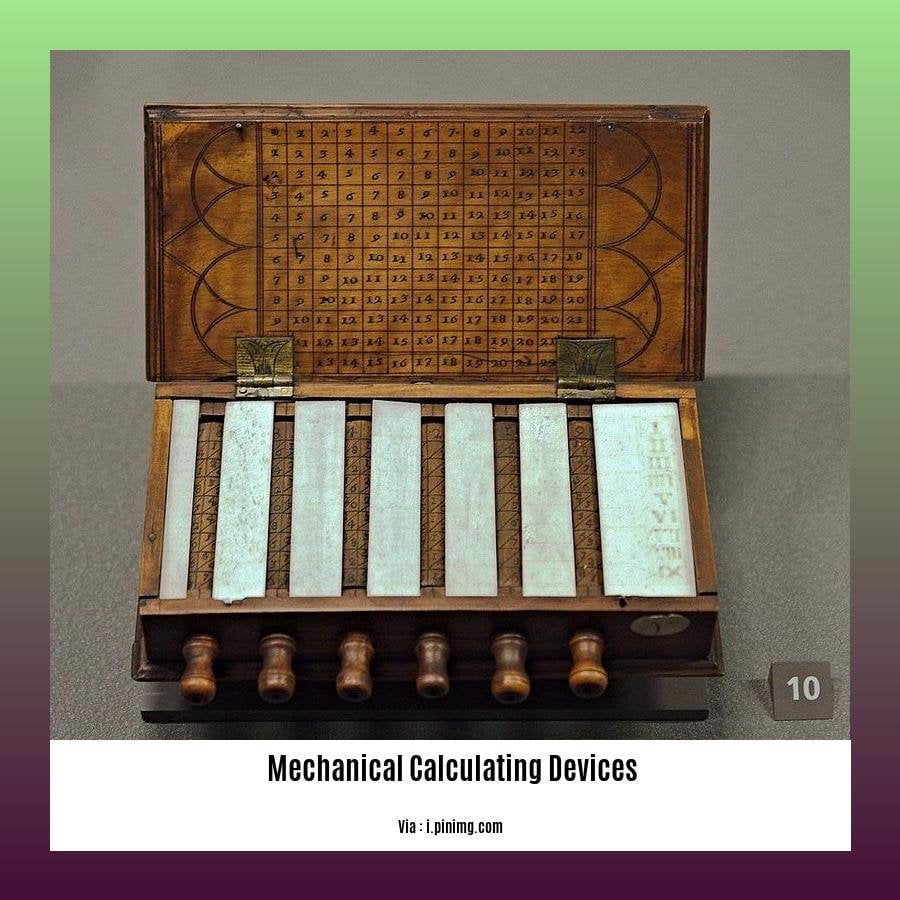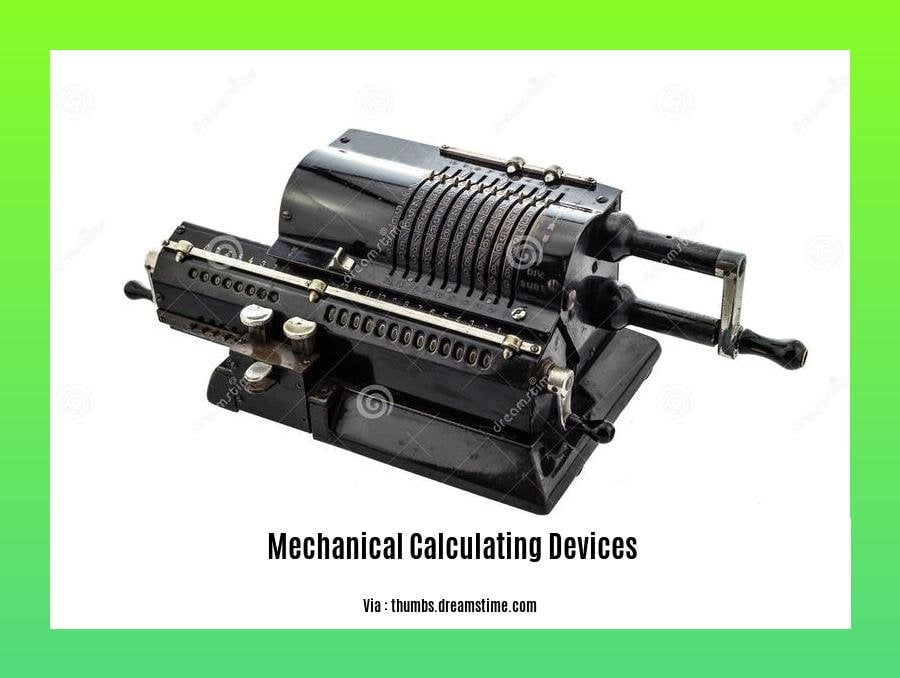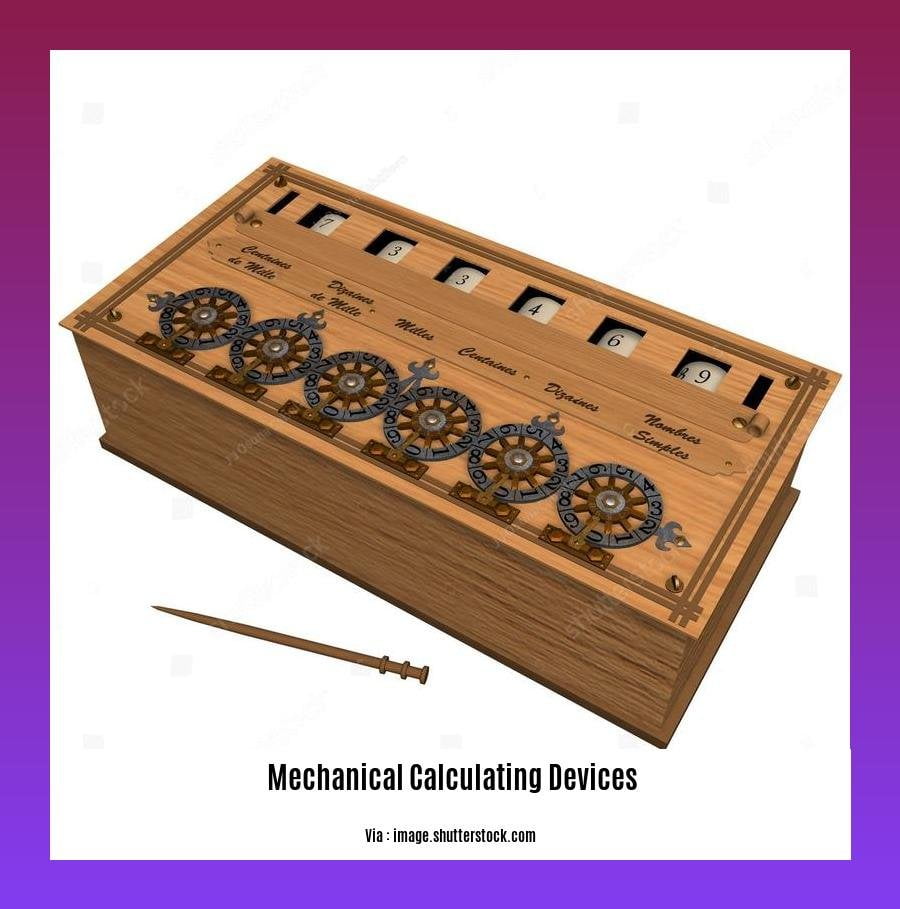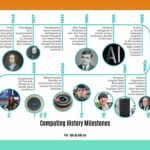Prepare to embark on an enthralling journey into the intricacies of mechanical calculating devices with this article, [Unveiling the Intricacies of Mechanical Calculating Devices]. As we delve into the captivating history and remarkable evolution of these mechanical marvels, we’ll uncover the ingenuity that shaped the foundations of modern computing.
Key Takeaways:
- Mechanical calculators automate basic arithmetic operations.
- The earliest mechanical calculator was invented in 1709.
- Direct multiplication machines emerged in the 1830s.
- Reciprocating and rotary mechanisms were used in 20th-century mechanical calculators.
- Computational aids were developed to simplify calculations and reduce errors.
Mechanical Calculating Devices: Exploring the Evolution of Calculators

Before our trusty smartphones, calculators were the go-to gadgets for crunching numbers. But have you ever wondered how they came to be? Let’s journey through the fascinating evolution of mechanical calculating devices.
A Brief History
The quest for easier math led to the first mechanical calculating device, the “calculating clock,” in 1709. Fast forward to 1834, Luigi Torchi introduced the first direct multiplication machine.
By the early 1900s, two main mechanisms emerged:
- Reciprocating: Numbers are added or subtracted by moving a series of gears back and forth.
- Rotary: Numbers are entered on dials, and a crank rotates to calculate results.
Key Players
Along the way, brilliant minds like Pascal, Leibniz, and Burroughs made significant contributions to the development of mechanical calculating devices. Pascal’s “arithmetical machine” laid the foundation, while Leibniz’s “step reckoner” introduced the binary system. Burroughs’s Adding Machine Company revolutionized the industry with affordable and reliable machines.
Types of Mechanical Calculators
Mechanical calculating devices come in various forms, each with its strengths:
- Pinwheel Calculators: A series of rotating wheels with numbered pins represent numbers.
- Slide Rule Calculators: Based on logarithmic scales, they can perform multiplication, division, and other operations without gears.
- Key-Driven Calculators: Numbers are entered using keys, which activate gear mechanisms to calculate and display results.
The Downfall
The rise of electronic calculators in the mid-20th century marked the demise of mechanical calculating devices. But their impact remains: they paved the way for the digital era and continue to fascinate enthusiasts worldwide.
Conclusion
Mechanical calculating devices bear witness to humanity’s relentless pursuit of simplifying complex calculations. Their ingenious designs and intricate mechanisms have shaped the course of mathematical history, laying the groundwork for the computing marvels we enjoy today.
Read the fantastic history of computers since the very first conception to what they are now.
Find out more about the invention of the transistor and how it revolutionized the digital world.
Learn how personal computing rose and changed the way we work, communicate, and play.
Key Mechanical Principles and Mechanisms Involved
Mechanical calculating devices have been around for centuries, and they employ a variety of key mechanical principles and mechanisms to perform computations. These principles and mechanisms include:
- Gears and levers: Gears are used to transmit motion and change the speed and direction of rotation. Levers are used to amplify force and change the direction of motion.
- Cams and followers: Cams are used to convert rotary motion into linear motion. Followers are used to follow the contours of a cam and transmit motion to another part of the device.
- Ratchets and pawls: Ratchets are used to prevent a device from moving in one direction. Pawls are used to engage ratchets and prevent them from moving.
- Springs: Springs are used to store energy and release it when needed. They can be used to return a device to its original position or to provide force for a calculation.
These are just a few of the key mechanical principles and mechanisms that are involved in mechanical calculating devices. By understanding these principles and mechanisms, you can gain a deeper appreciation for the ingenuity of these devices and the role they have played in the history of computing.
Key Takeaways:
- Mechanical calculating devices use a variety of key mechanical principles and mechanisms to perform computations.
- These principles and mechanisms include gears, levers, cams, followers, ratchets, pawls, and springs.
- These devices played a crucial role in the history of computing before the advent of electronic computers.
Citations:
- Mechanical Computing: The Computational Complexity of Mechanical Systems
- Mechanical Computing: The Computational Complexity of …
Advantages and Limitations of Mechanical Calculators

Advantages
- Exceptional Accuracy: Mechanical calculators provide highly precise computations, ensuring reliable and accurate results.
- Manual Control: They offer manual input and operation, giving users full control over calculations, reducing the risk of errors.
- Portability: Many mechanical calculators were compact and portable, facilitating easy usage on the go.
- Historical Significance: These devices represent a significant milestone in the history of computing, showcasing the ingenuity and advancements made over time.
Limitations
- Slow Speed: Compared to modern electronic calculators, mechanical calculators operate at much slower speeds, limiting their efficiency for complex or lengthy calculations.
- Limited Functionality: Mechanical calculators typically perform a specific set of arithmetic operations, restricting their versatility.
- Obsolescence: With the advent of electronic calculators, mechanical calculators have become obsolete for practical use.
- Skill Requirement: Operating mechanical calculators requires a certain level of skill and knowledge, which can be a barrier for some users.
Key Takeaways:
- Mechanical calculators revolutionized computations, providing accurate and portable solutions.
- Their limitations, including slow speed and limited functionality, led to their decline with the rise of electronic calculators.
- These devices remain historically significant, showcasing the evolution of computing technology.
Sources:
- Mechanical Calculating Devices – A History of Early Calculators
- Mechanical Calculator – The Ultimate Guide
Impact on the Development of Modern Computing
Navigating the Tangled Web of Ancient Codes and Gears
From humble beginnings in the sands of time, the journey of mechanical calculators to the forefront of mathematical prowess is a mesmerizing tale of ingenuity and perseverance. These enigmatic machines laid the very foundations upon which modern computers rest today.
Silent Sentinels of Computation
Mechanical calculators, unlike their electronic counterparts, operate without the humming embrace of electricity. Instead, they harness the power of intricate mechanisms—a symphony of gears, levers, and dials—to perform incredible feats of calculation. These mechanical marvels were the first to automate arithmetic operations, paving the way for the technological marvels we take for granted today.
Guiding Light for Future Generations
The legacy of mechanical calculating devices extends far beyond their immediate computational prowess. They were the harbingers of modern computing, introducing concepts and principles that would later shape electronic calculators and computers. The binary number system, for instance, found its roots in the mechanical fabrics of machines such as the Analytical Engine designed by Charles Babbage.
Precision in Motion
Mechanical calculators were not merely tools for crunching numbers; they were also symbols of precision and efficiency. Their ability to automate calculations reduced human error, leading to unprecedented accuracy in scientific, financial, and engineering domains. The development of these devices showcased the remarkable precision that mechanics can achieve, influencing the design of subsequent computing technologies.
Fueling the Fires of Technological Revolution
Mechanical calculators played a pivotal role in fueling the fires of the Industrial Revolution. The demand for accurate and rapid calculations in industries such as manufacturing, finance, and science created a fertile ground for innovation. Inventors and engineers relentlessly pushed the boundaries of mechanical computation, leading to a cascade of advancements that paved the way for the digital age.
Key Takeaways:
- Mechanical calculating devices laid the groundwork for modern computing by automating arithmetic operations.
- They introduced concepts and principles that would shape future electronic calculators and computers.
- Mechanical calculators promoted precision and efficiency, reducing human error in various industries.
- The demand for mechanical calculators during the Industrial Revolution accelerated technological innovation.
- These devices paved the way for the digital age, setting the stage for the computers we rely on today.
Relevant URL Sources:
- Mechanical Computing: The Computational Complexity of Mechanical Devices for Mathematical Tables and Functions
- On-chip Mechanical Computing: Status, Challenges, and Opportunities
FAQ
Q1: What are mechanical calculating devices?
A1: Mechanical calculating devices are machines that use mechanical mechanisms to perform arithmetic operations automatically, such as addition, subtraction, multiplication, and division.
Q2: Who invented the first mechanical calculator?
A2: The first known mechanical calculator was invented by Giovanni Poleni in 1709.
Q3: How do mechanical calculators work?
A3: Mechanical calculators typically use a series of gears and levers to perform calculations. When the user enters a number, the gears and levers move in a specific way to calculate the result.
Q4: What were the benefits of mechanical calculators?
A4: Mechanical calculators were faster and more accurate than manual calculations, which made them ideal for tasks such as accounting, engineering, and scientific research.
Q5: When were mechanical calculators replaced by electronic calculators?
A5: Electronic calculators, which were smaller, cheaper, and more powerful, began to replace mechanical calculators in the 1970s.

![A Journey Through the History of Computing: From Its Humble Origins to Modern Innovations [history of computing ss1] history-of-computing-ss1_2](https://www.lolaapp.com/wp-content/uploads/2023/12/history-of-computing-ss1_2-150x150.jpg)







